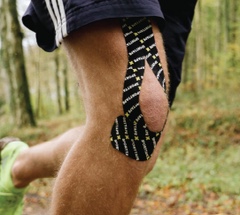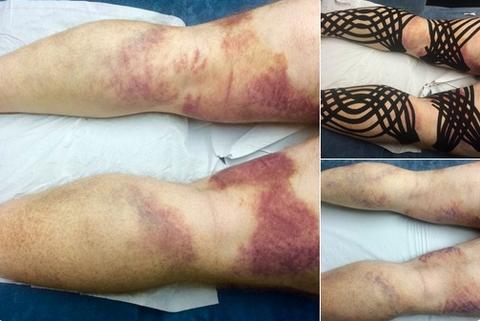What is Kinesiology Tape and How Does it Work?
By Mike James | 11th June 2016 | General, Advice
You may have heard a lot of different things about Kinesiology Tape - that mysterious coloured tape worn by athletes all over the world. But what to actually believe - does it work, and if so, how?
Kinesiology tape can be used to help treat many different sporting injuries - such as runners knee, shoulder pain, arm pump and tennis elbow. The current research on when, how and why kinesiology taping works is still limited in terms of controlled research trials but it’s popularity is increasingly incredibly quickly due to the number of people having felt it gives good results. Some studies have shown incredible results in pain relief, muscular contraction force and range of motion (some links to a small selection below) but more is needed. SPORTTAPE were the official supplier of kinesiology tape to Team GB at London 2012 and have seen and experienced the positive effects of kinesiology tape when trying to support and aid weakened muscular structures when returning from injury (of which we've had a fair few between us over the last couple of years) and in lymphatic drainage (think bruising and swelling, the perfect example is dead leg).To put simply, we know it works, but right now no-one is 100% sure how.

The fact is that Kinesiology taping will not change the pathologic nature of tissue - it's not going to change your musculoskeletal structure - so must be working in other ways. We have theorized that the most likely response to taping is a sensory nervous system response to a stimulus of the stretch receptors in your skin. This has the potential to increase motor control and provide immediate pain relief. Some of the best responses we've seen have been through lymphatic drainage, you may have seen the thin wavy pattered taping method. This taping method gives a slight lift to the skin, creating the above mentioned neurosensory response and promoting lymphatic flow below the skin.

These photos were taken 24 hours apart by one of our SPORTTAPE PRO's - Rex Physiotherapy.. You can see how the tape has helped to clear the bruising quickly.
Most often we have found that the success of a taping application comes down to many different things. It can certainly help as part of the prevention and recovery process, but understanding it's limitations is essential too. The first step is to understand the reasoning behind the application, and that is where your medical professional comes in. They will be able to help deduce the root cause of your injury and whether kinesiology taping can and should be used as part of your recovery process, or to prevent any further injury. They'll also be able to help you apply the tape yourself, making sure you use the right balance of stretch and cuts to treat the injury. The good news is, if you're doing it yourself you can't really get it wrong - we actively encourage experimentation and the worst that can happen is that the tape has no effect.
For more information visithttps://www.sporttape.co.uk/pages/sporttape-faqs
Ieuan Thomas
SPORTTAPE
Like SportsInjuryFix on Facebookhereand follow us on twitter @sportsinjuryfix
Links to positive studies
(1) Kaplan et al (2016) Short-Term Effects of Kinesio Taping in Women with Pregnancy-Related Low Back Pain: A Randomized Controlled Clinical Trial
https://www.medscimonit.com/download/index/idArt/898353
(2) Chen et al. (2008) Biomechanics Effects of Kinesio Taping for Persons with Patellofemoral Pain Syndrome During Stair Climbing
https://link.springer.com/chapter/10.1007%2F978-3-540-69139-6_100
(3) Taradaj et al (2010) Evaluation of the effectiveness of kinesio taping application in a patient with secondary lymphedema in breast cancer: a case report
(4) Chan et a. Effects of KT on the timing and ratio of VMO and Vastus Lateralis with PF Pain
https://isbweb.org/images/conf/2007/ISB/0216.pdf
(5) González-Iglesias et al (2009) Short-term effects of cervical KT on pain and cervical range of motion in patients with acute whiplash
https://www.jospt.org/doi/pdf/10.2519/jospt.2009.3072
